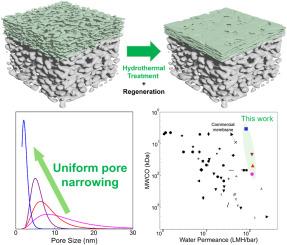用于控制筛分尺寸的水热重排纤维素膜
IF 8.4
1区 工程技术
Q1 ENGINEERING, CHEMICAL
引用次数: 0
摘要
可生物降解聚合物比传统的石油基聚合物更容易分解,因此对减少污染和促进可持续发展非常重要。再生纤维素(RC)就是这样一种聚合物,因其耐化学腐蚀性和亲水性,被广泛应用于水净化和制药领域。由于纤维素的不溶性限制了它的直接使用,醋酸纤维素(CA)等衍生物首先要通过再生过程转化回 RC,以利用其功能特性。但在这一过程中,膜结构可能会受到破坏,从而影响其分离性能。在这里,我们展示了在再生之前只需将 CA 膜浸泡在热水中,就能显著改善 RC 膜的结构完整性,并保持其筛分性能。预处理会导致平面收缩,但不会破坏纤维素的一般特性,从而可以单独调整孔径大小。这种直接的方法可以精确调整膜的孔隙特性,以适应特定的应用,例如调整孔隙大小以有效筛分具有特定分子质量的材料,同时保持高透水性。我们的研究结果表明,水热处理有可能提高 RC 膜的过滤性能,并扩大其应用范围。本文章由计算机程序翻译,如有差异,请以英文原文为准。

Hydrothermally rearranged cellulose membranes for controlled size sieving
Biodegradable polymers are important for reducing pollution and promoting sustainability as they break down more easily than traditional petroleum-based polymers. One such polymer is regenerated cellulose (RC), which is widely used in water purification and pharmaceuticals due to its chemical resistance and hydrophilicity. Since its direct use of cellulose is limited by its insolubility, derivatives like cellulose acetate (CA) are first converted through a regeneration process back into RC to make use of its functional properties. During this process, however, the membrane structure may be compromised, impairing its separation performance. Here we show that simply soaking CA membranes in hot water before regeneration significantly improves the structural integrity of RC membranes, retaining the sieving properties. The pretreatment causes planar shrinkage without disrupting the general characteristics of cellulose, allowing for sole adjustment of pore size. This straightforward approach enables precise tuning of membrane pore properties to suit specific application, such as adjusting pore size for efficient sieving of materials with particular molecular masses, all while maintaining high water permeance. Our findings suggest that hydrothermal processing has the potential to enhance the filtration performance of RC membranes and broaden their range of applications.
求助全文
通过发布文献求助,成功后即可免费获取论文全文。
去求助
来源期刊

Journal of Membrane Science
工程技术-高分子科学
CiteScore
17.10
自引率
17.90%
发文量
1031
审稿时长
2.5 months
期刊介绍:
The Journal of Membrane Science is a publication that focuses on membrane systems and is aimed at academic and industrial chemists, chemical engineers, materials scientists, and membranologists. It publishes original research and reviews on various aspects of membrane transport, membrane formation/structure, fouling, module/process design, and processes/applications. The journal primarily focuses on the structure, function, and performance of non-biological membranes but also includes papers that relate to biological membranes. The Journal of Membrane Science publishes Full Text Papers, State-of-the-Art Reviews, Letters to the Editor, and Perspectives.
 求助内容:
求助内容: 应助结果提醒方式:
应助结果提醒方式:


